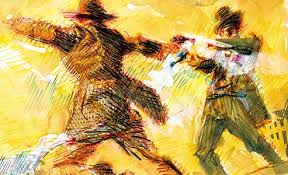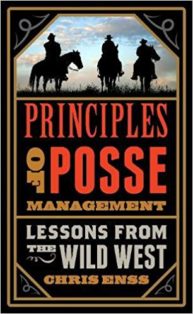Enter to win a copy of
The Principles of Posse Management:
Lessons from the Old West for Today’s Leaders.

Sheriff Harry Morse removed a Model 1866 Winchester, carbine rifle from the leather holster on his saddle and cocked it to make sure he had a bullet in the chamber. He surveyed the sprawling canyon deep in the depth of the Panoche Mountain, more than fifty miles outside of Gilroy, California. In the distance below were three, small, adobe houses, and Morse had every reason to suspect members of outlaw Juan Soto’s gang were inside one of the buildings.
High above the sheriff and his eight member posse was a seemingly inexhaustible mat of black, rainless clouds moving steadily across the world. Morse watched the sun disappear behind the billows and exchanged a determined look with Captain Theodore Winchell on horseback next to him. Winchell, an undersheriff from Alameda County, had been riding with Sheriff Morse for several months in search of the fugitive. San Jose sheriff Nick Harris and six other deputies made up the rest of the posse. All the lawmen had years of experience tracking lawbreakers through the northern California terrain. Each was an exceptional shot and could hold his own in hand to hand combat.
Harry Morse had been sheriff of Alameda County for more than nine years. From 1864, when he took the job, to April 1871, when he peered down on the possible hiding place of Juan Soto’s men, Morse had traversed the hills and plains of eastern and northern Alameda County in search of horse thieves, highwaymen, and cutthroats. Until Morse took the job at twenty-eight years of age, most lawmen were afraid to venture too far to catch outlaws. Worried they would be outnumbered the criminals went about their business unconcerned they would ever be apprehended. Sheriff Morse, along with Nick Harris and Theodore Winchell, changed all that.
The officers and their deputies familiarized themselves with the haunts of the outlaws and the topography of the country where the bad guys were known to roam. They learned the locations of ranches, springs, and mountain trails as well as acquainted themselves with the inhabitants and their occupations. They knew where to hide and wait along trails for lawbreakers to pass, and, armed with that knowledge, they knew what to do to avoid an ambush.
Juan Soto, the man Sheriff Morse and his posse were tracking, was a thief and a murderer. He had a reputation as a brutal man who would stop at nothing to get what he wanted. Soto mainly operated in the central part of California but, like the other bandits before him, went wherever the possibility of loot beckoned him. For more than four years, the 6’2, two-hundred twenty pound, half-Indian, half-Mexican man had terrorized the area from the Livermore Valley to San Luis Obispo. Soto and his gang of desperadoes robbed stages, stage stops, lone emigrants, and prospectors. Their victims were often beaten or killed. Soto’s dark features and general express of animal ferocity earned him the name “the human wildcat.” He had black, slightly crossed eyes, a mane of black hair, and a bushy beard and mustache. The April 10, 1871, edition of the San Francisco Chronicle described his appearance as the “physical manifestation of as cruel a spirit as ever animated a human being.”

To learn more about the great posses of the frontier read
The Principles of Posse Management:
Lessons from Old West for Today’s Leaders.

